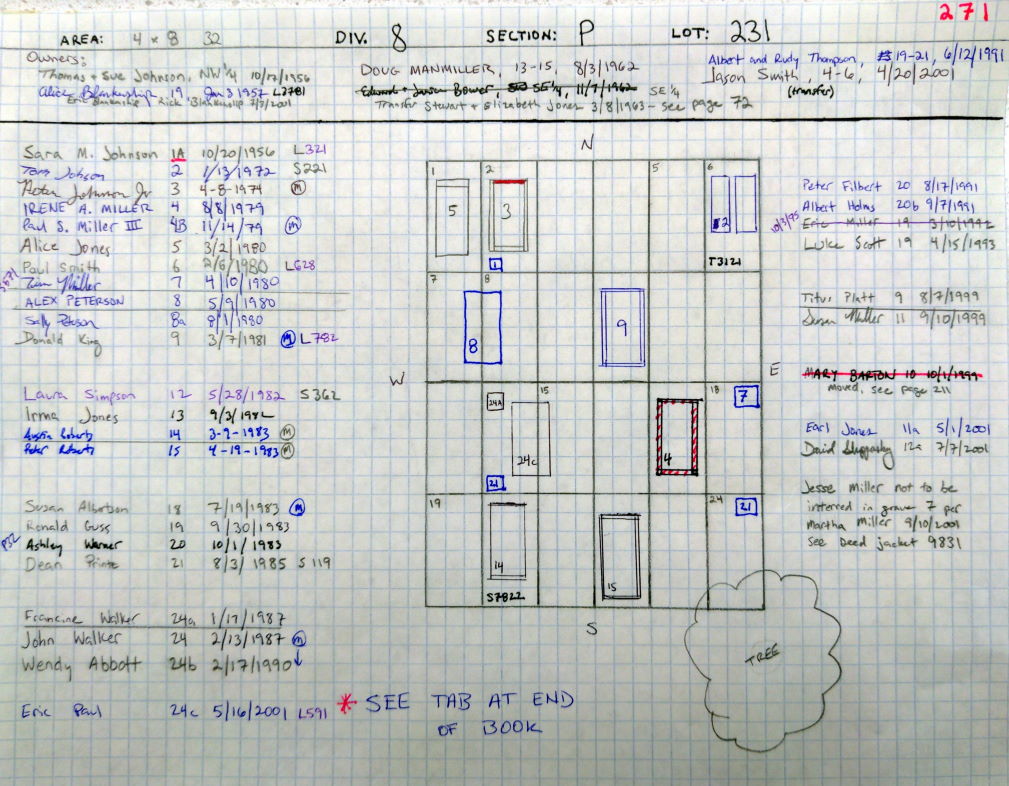Living and working through 2020 has illustrated the value of managing a cemetery’s records, customer service, and sales process through the cloud. Enabling staff and customers to have online access to a cemetery’s property inventory and documents allows for sales, consultations, and work to take place in a virtual environment. Not only does a computerized system lead to smoother business operations regardless of families’ ability to come to the cemetery, it also adds value to the services you offer and enables you to reach a wider audience than those in physical proximity to your location. Implementing a software system for managing the entry of your new records and business processes is a great step, and if you are looking to also bring your historic records and inventory into this system, there are multiple options to consider.
The effort to get the records and maps from paper into a useful and accurate digital format can be challenging and time intensive. What are those options? What is the best way? How can you ensure accuracy while also not overtasking the staff most knowledgeable and critical to the office? In this article we will review two options. The first is to digitize the records as-is through a process known as OCR (Optical Character Recognition). OCR is often seen as the most economical solution, as it is generally less expensive than the second, more involved option of manual data entry. Both can be viable choices, but which is the correct choice depends on the scope of the records being computerized, as well as what the cemetery hopes to do with those records once they’re brought online. Many consider OCR simply for the potential cost savings, but it can have significant limitations. OCR has its appropriate place, but when misapplied, it can cause problems.
OCR – Not “One Size Fits All”
OCR is a form of scanning technology that takes a picture of written or printed text—such as a book, business card, contract or burial card—and pulls information it scans from that source and converts it to digital text. There are many incredible examples of how OCR makes everyday life easier in and out of the business world. Google Drive and Microsoft OneDrive will automatically convert the text in an image or PDF document if you open them in Docs mode. Many business card scanning apps will connect to your smart phone and automatically load contacts into your CRM. Portable OCR devices are available for the visually impaired to help them convert text into audio. Online and mobile bank deposits, and many other industries, are also using OCR on an everyday basis.
Advancements in artificial intelligence technology have carried into the OCR realm, and today it is possible to achieve up to 95 to 99 percent accuracy on typewritten records, and 80 to 90 percent accuracy on clean handwritten characters (although in both cases it usually requires human review to achieve this level of accuracy). That begs the question: does OCR have a place in computerizing cemetery records? The answer is yes, with a caveat. OCR is something to consider when a cemetery only wishes to replicate its paper records on the computer, with little or no time spent interpreting the data and making corrections. It works especially well when a cemetery just needs to digitize one or two fields of data on a given, standardized record (such as a contract number or section name) to create a set of documents searchable by those fields. This approach is typically used when a cemetery has both limited needs for their data and either a limited budget or timeline to work with. You can make a set of documents available on the computer instead of the filing cabinet, but will not gain the efficiencies offered by a full digital conversion, where records are searchable by field, inventory can be managed real-time, property can be visualized, custody of ownership can be tracked, audit trails on record changes are logged and more. Fundamentally, making paper records available on the computer still leaves the organization operating on paper, just in a different format.
OCR is limited by more than just the accuracy of reading the characters on the page
In the context of cemetery records, OCR is limited by more than just the accuracy of reading the characters on the page. Even if the technology achieved 100% accuracy for matching characters, the OCR software is not able to interpret what the records mean when it comes to complicated cases like property transfers, buybacks, disinterments, etc. The process becomes even more complicated when more data fields are added or when there are other mitigating factors, such as poor handwriting or records where information has been crossed out and updated over time. For cemeteries with records that span decades, format changes in either the physical record itself or the information contained within are likely, and these will need to be accounted for in either the setup or cleanup phase. For example, if a cemetery’s layout used to involve whole lot numbers (1, 2, 3, etc.) but over the years has subdivided these lots in non-uniform ways (Lot 1, Graves 1 through 8; Lot 1, NE Corner; Lot 1, Middle of South Half; etc.), an OCR system could incorrectly pull this information into the database, making it more difficult to find in the system and, more importantly, to determine if the now-divided property is available or not. These errors can be remedied on the back-end through manual review of the digitized data, but it is time-consuming and could add to the overall cost of the project. OCR has its place, but it is not a “one size fits all” solution.
Manual Data Entry – The Human Touch
Sometimes a cemetery’s records are complex, non-standard, or just plain difficult to read. Other complications could arise, such as ownership changing hands; a decedent being disinterred; or the property being sold back to the cemetery, making it available for resale. With records like this, deeper interpretation than what OCR is currently capable of is needed, and that can only be accomplished with civilization’s oldest scanner: the human eye. By having people go through a cemetery’s records manually, there is a higher likelihood that existing errors will be caught and not brought into the database. Further, a standard template for how records will be entered and viewed can be established, and any deviations can be properly categorized for accuracy and ease of access. There are many cases where careful analysis and entry of records in this manner has resulted in a cemetery discovering unsold inventory or double sold property, either making or saving the cemetery more than it cost to convert the records into digital format.
This manual process can be as hands-on or hands-off for the staff as a cemetery manager would like. If a cemetery has the time, it can all be done in-house. In this case, the manager could examine the data, establish a set of rules for interpreting what’s on the documents so that the data on the other end is uniformly searchable, and then dedicate personnel to the task. If you are fortunate enough to have access to interns, volunteers, or history buffs, this is a wonderful project for them. As records are discovered that do not comply with the rules, these can be flagged for review by the manager to leverage their knowledge while protecting their time from the bulk of the entry work. Due to the level of analysis required, Quality Control measures should be defined and implemented to ensure that these rules are being followed properly. This can be as simple as having a second set of eyes on each record at the start of the process. Taking these measures holds staff accountable and allows for course correction early on, if needed.

Depending on the size of the cemetery, the manual data entry process could take months or longer, but it is doable. A cemetery could also outsource the work to a third party by transferring key knowledge of the records to a project manager and staff who, with a set of analysis rules and quality control guidelines, can take care of the majority of the entry work. This allows cemetery staff to remain focused on day-to-day operations while leveraging their knowledge of difficult records.
Regardless of who enters the information from the paper records, it is critical to establish a baseline against which all records will be entered. Typically, this is best done by starting with a data set of all property inventory, established off of the maps, and reconciling any subsequent records (owners, burials, etc.) against that inventory. This method forces the paper records to reconcile with the maps, and it also works out discrepancies that almost always emerge in a paper record system over time.
As you can see, this is an involved process, but it has a greater chance of ensuring accuracy and creating an easily searchable database than OCR can on its own. Streamlining business processes and increasing office efficiency, however, is simply the beginning. From this point, you are able to offer families an elevated service experience, such as building sales contracts with the click of a button, tracking and visualizing the history of client interactions automatically when creating working orders, reserving property, or other important tasks.
Each cemetery and each record set has its own set of challenges and priorities. When assessing what steps your cemetery should take in order to bring your historic records into the digital realm, consider first how you intend to use the data and what will set you up for achieving your long term goals. Do you simply need a remote way of accessing your paper records? OCR may provide a viable and affordable path. As your cemetery seeks to grow in its ability to provide remote services, facilitate interactive customer experience, or utilize the data to reach your customer base, a more robust solution may be found through data entry.
This article was first published in the Catholic Cemetery Magazine in January 2021.
Related Articles
Articles related to the one you just read!
What are cemeterians saying about webCemeteries?
This [website] project was quite an odyssey with plenty of twists and turns. The webCemeteries website design team weathered the storm. I think it’s more than fair to say that without their efforts, we would not have gotten this over the finish line…and with such an excellent outcome.
Mark J. DePalma
Forest Lawn Buffalo




